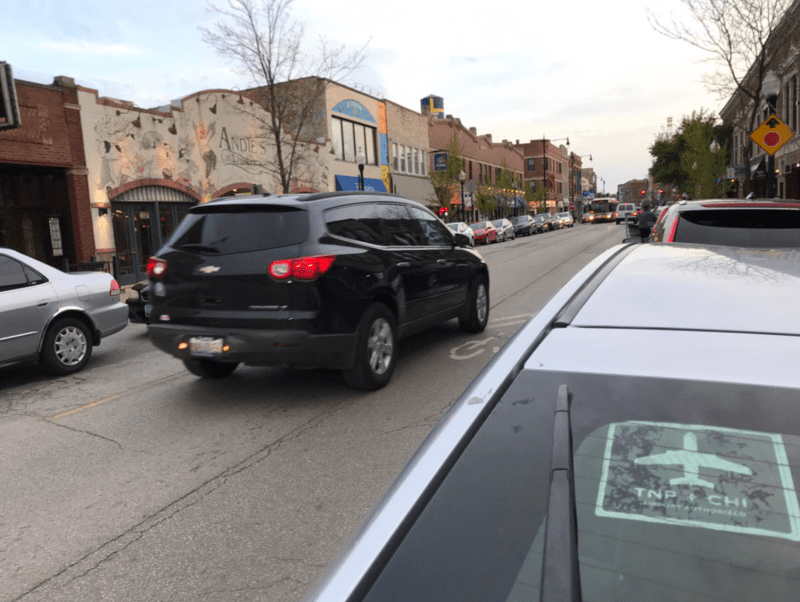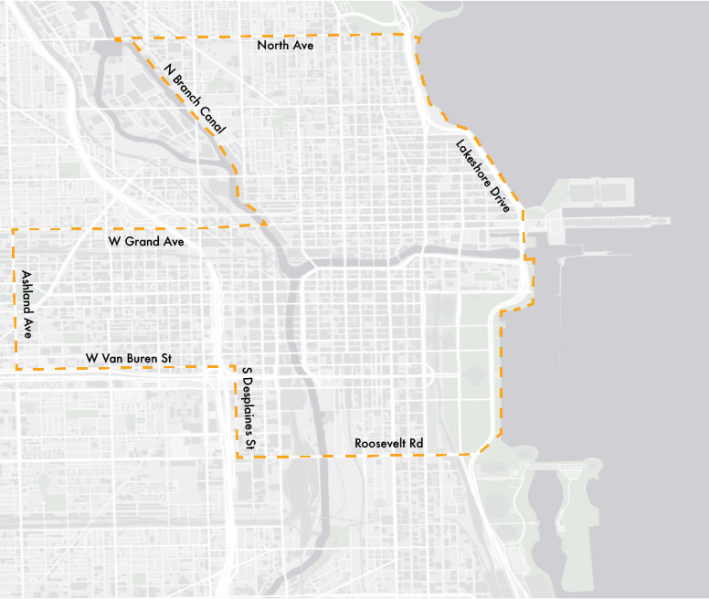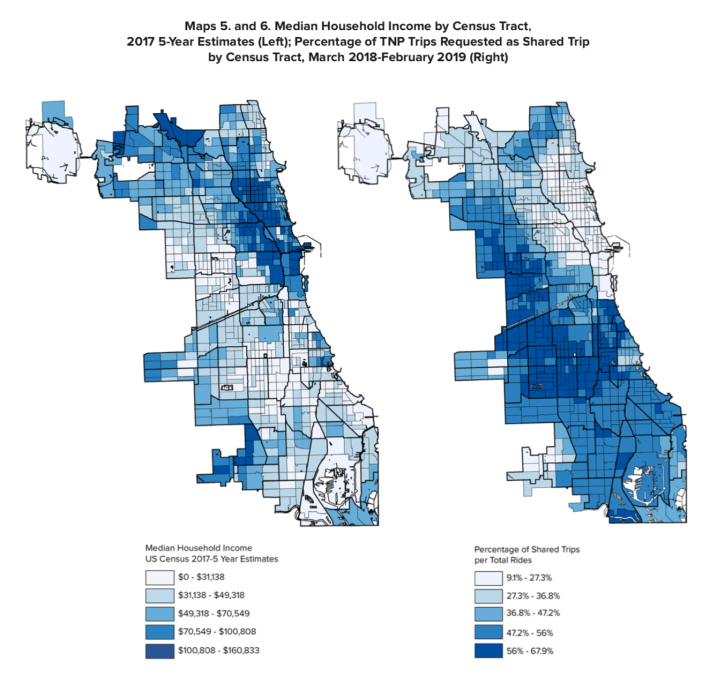Mayor Lightfoot wants to jack up the price of ride-hailing trips, and that’s a very good thing
4:22 PM CDT on October 18, 2019

Photo: John Greenfield
The Active Transportation Alliance has launched a petition where you can voice your support for fair ride-hail fees and better CTA service to elected officials. Add your name to the petition here.
Propped up by venture capital, ride-hailing service like Uber and Lyft are artificially cheap, and with dependable on-demand pickups, they're awfully convenient. They also help keep drunk drivers off the road, provide a handy option for people with mobility challenges, and help bridge gaps in the transit network in underserved communities. But as Streetsblog USA pointed out, ride-hailing services are bad for cities in a myriad of ways:
- They increase driving, congestion (which slows down buses), pollution, and crashes
- They spend half their time "deadheading," driving around with no passengers
- They largely operate in transit-friendly areas
- They mostly replace walking, biking, and transit trips
- Reduced transit ridership, fare box revenue, and political support leads to service cuts
That's why it's great news that Chicago Mayor Lori Lightfoot today announced plans to hike fees on ride-hailing and use some of the revenue for transit, particularly bus service. Chicagoans shouldn't be surprised by this move, since Lightfoot's transportation platform promised that she would "help write and introduce an ordinance to increase fees for ride-hail trips that begin in the Loop."
The new rules will focus on increasing the fees on single-passenger rides and downtown rush-hour trips, while lowering the taxes a bit on shared rides in the neighborhoods. The city projects that the new pricing scheme will generate $40 million.
“Our city, like many others across the nation, has experienced skyrocketing congestion growth due in part to the rapid growth of ride-hailing companies, making it increasingly difficult for those who rely upon Chicago’s streets for commerce or transportation, and plaguing our downtown,” said Lightfoot in a statement. “Using an evidence-based approach to combat our congestion challenges, Chicago is taking these first steps to improve mobility and further our goals of ensuring sustainable, affordable and reliable access to transportation options in every neighborhood.”
The new rules are informed by an analysis the city conducted of ride-hailing trips since 2015, which found that almost half of all Chicago trips start or end downtown, and one out of three trips both starts and ends downtown. On top of that, most ride-hailing trips in Chicago are hailed by a single customer, as opposed to trips via shared-ride services like Uber Pool and Lyft Line. All of this is further evidence that ride-hailing is putting in more cars on the road, particularly in the transit-rich central business district.
The city is proposing a new variable Ground Transportation Tax structure. Under the current GTT, a flat rate of $0.60 is assessed per ride-hailing trip citywide (which is used to fund CTA infrastructure), and a $5.00 flat rate is assessed per trip in special zones, including the airports, Navy Pier and McCormick Place. Here's the proposed fee structure:
- Decreasing the GTT on all citywide shared ride-hailing trips from $0.60 per trip to $0.53 per trip.
- Increasing the GTT on all citywide single ride-hailing trips from $0.60 per trip to $1.13 per trip.
- Assessing a downtown zone surcharge, placing an additional $1.75 fee per trip for single rides and $0.60 per trip for shared rides.
No changes are proposed to the current $5 special zone fee, the $0.10 per trip accessibility fee or the $0.02 per trip administrative fee. The downtown surcharge will be assessed during from 6 a.m. to 10 p.m. on weekdays, when congestion is worst. That means the downtown tax won't be in effect during prime nightlife hours, so it won't be a disincentive to using Uber or Lyft to get home safely after a night of drinking. Here's the map of the proposed downtown zone.

The reduction in the fee for shared trips will help ensure that the new rules don't unduly impact lower-income communities on the South and West sides. The city's analysis found that more than half of ride-hailing trip requests in those parts of town are for shared trips, as opposed to only 30 percent downtown and on the North Side.

According to the mayor's office, a portion of the $40 million in revenue projected as a part of the 2020 budget will be earmarked for the CTA and Chicago Department of Transportation's Bus Priority Zones program, which focuses on seven routes on the South and West sides. Originally budgeted at $5 million, the bus program is expanding to $20 million, largely thanks to $17 million in federal Congestion Mitigation and Air Quality funding, which was recently approved by the Chicago Metropolitan Agency for Planning.
The Bus Priority Zone Program seeks to eliminate bus “slow zones” caused by bottlenecks along the city’s busiest corridors. CDOT is currently starting work on the first element in a series of projects along 79th Street. The #79 bus is one of the Chicago’s highest ridership routes. The upgrades include red CTA bus-only lanes overhead signage, and special signals at intersections that give buses a head start before private vehicles get a green light.

These elements are already in place on the downtown Loop Link corridor, which has seen only modest bus speed improvements, partly due to lax enforcement of the bus-only lanes. However, Lightfoot hopes to help pass state legislation to legalize camera enforcement of bus lanes, which already exists in New York City.
Other corridors being considered for future or additional improvements are: Halsted Street (#8), Western Avenue (#49), Pulaski Road (#53), 63rd Street (#63), Chicago Avenue (#66), Belmont Avenue (#77) and/or 79th Street (#79). Planning for the new improvements is expected to take place in the remainder of 2019 and into early 2020, with construction work possibly starting next year.
Since the launch of the Bus Priority Zone Program this spring, work has begun on the corner of Chicago and Ogden Avenues. Other projects are happening this year on Western Avenue near the Blue Line CTA stop, and on Wacker Drive at LaSalle Street and Wacker at Michigan Avenue.
“We applaud Mayor Lightfoot for taking a bold first step to address the inequity in our transportation system," said Active Transportation Alliance interim director Melody Geraci in a statement on the proposed ride-hailing fee structure. "These new fees will help ease congestion and reduce emissions on many of the city’s busiest corridors. When paired with the expansion of Bus Priority Zones, they make it safer and easier to walk, bike, and ride transit in neighborhoods across the city.”
Some of the ride-hailing revenue will also be used to pay for a study of congestion pricing (charging an extra fee to drive in congested areas) that will look at how traffic jams impact Chicago neighborhoods.
In addition, the Chicago Department of Business Affairs and Consumer Protection will be seeking additional data from the city’s three active ride-hailing companies, Uber, Lyft and Via, on driver compensation, total number of passengers per trip, and miles traveled without a passenger (deadheading.) The city says the additional data, which would be posted on the City’s Data Portal, will allow the BACP to "implement the full extent of its regulations on a relatively new industry," to roll out on accessibility and equity initiatives, and to inform long-term transportation plans.
Predictably, the ride-hailing companies aren't pleased about the news, arguing that the additional fees will make ride-hailing trips in Chicago more expensive than any other U.S. city. Expect some heavy lobbying on their part to try to kill the legislation.
The city should consider taking some additional steps to make sure that the fee hikes aren't regressive, such as offering discounts for people who are eligible for handicapped parking placards, and trips to parts of town that are poorly served by transit. It should also look into the potential impact on the income of ride-share drivers and consider taking steps to mitigate that, such as capping the number of ride-hailing drivers, which would also help reduce congestion.
But as I noted above, ride-hailing has generally been terrible for cities, so making downtown and single-passenger trips more expensive is a feature, not a defect, of Lightfoot's plan.
Click here to add you name to Active Trans' petition in support of the fair ride-hail tax plan.
In addition to editing Streetsblog Chicago, John writes about transportation and other topics for additional local publications. A Chicagoan since 1989, he enjoys exploring the city on foot, bike, bus, and 'L' train.
Read More:
Stay in touch
Sign up for our free newsletter
More from Streetsblog Chicago
One agency to rule them all: Advocates are cautiously optimistic about proposed bill to combine the 4 Chicago area transit bureaus
The Active Transportation Alliance, Commuters Take Action, and Equiticity weigh in on the proposed legislation.
State legislators pushing to merge CTA, Pace, and Metra into one agency spoke at Transit Town Hall
State Sen. Ram Villivalam, (D-8th) and state Rep. Eva-Dina Delgado (D-3rd), as well as Graciela Guzmán, a Democratic senate nominee, addressed the crowd of transit advocates.



